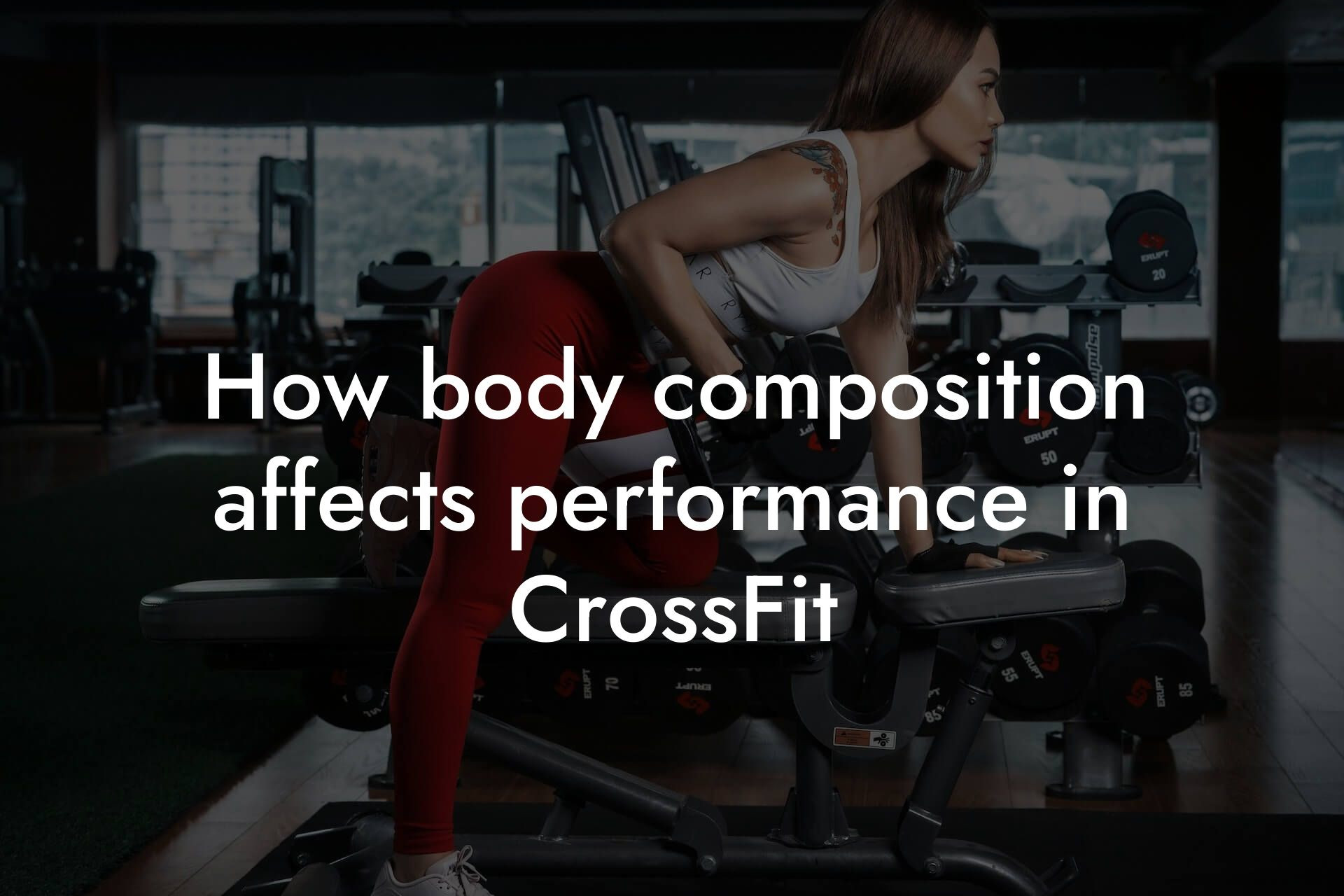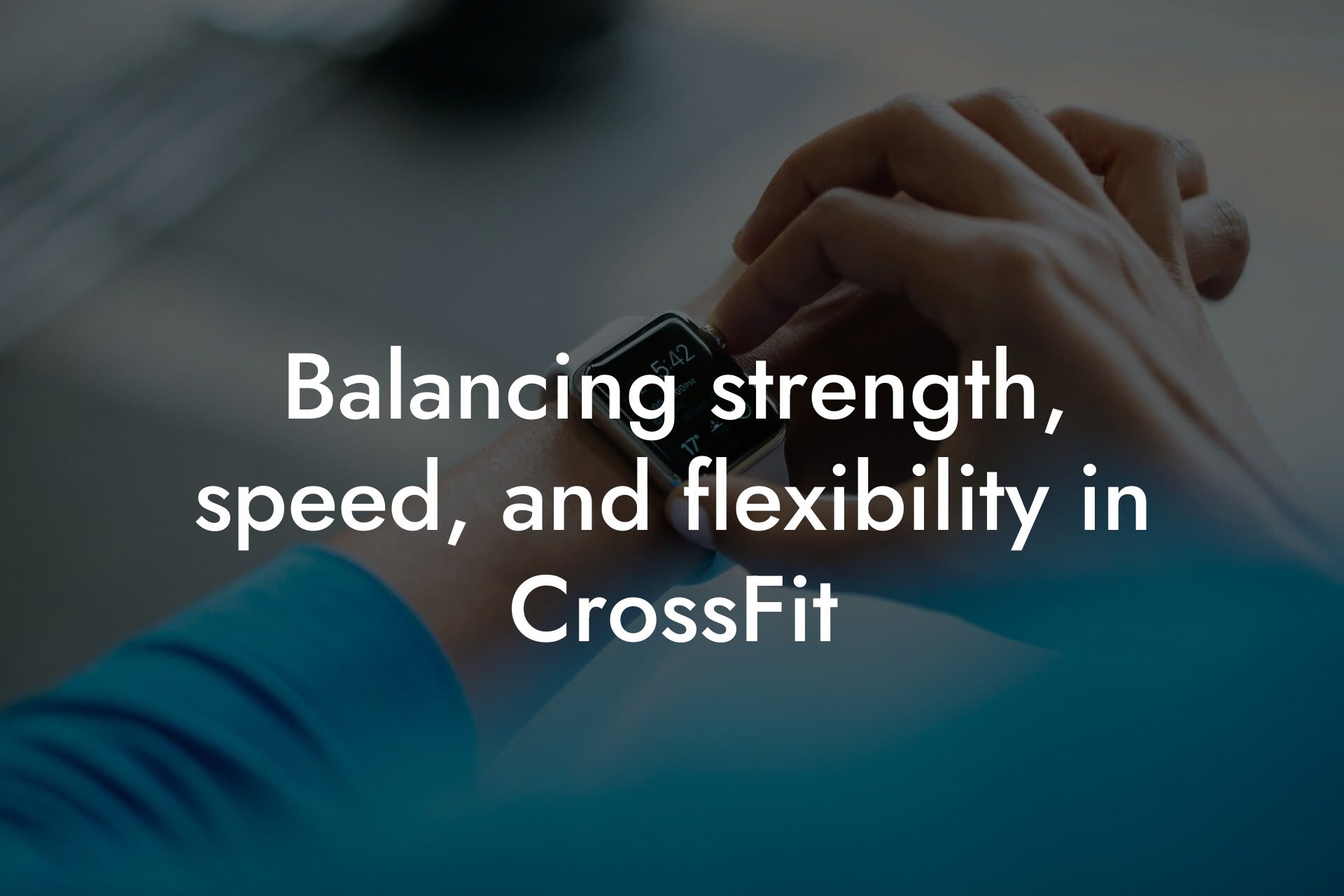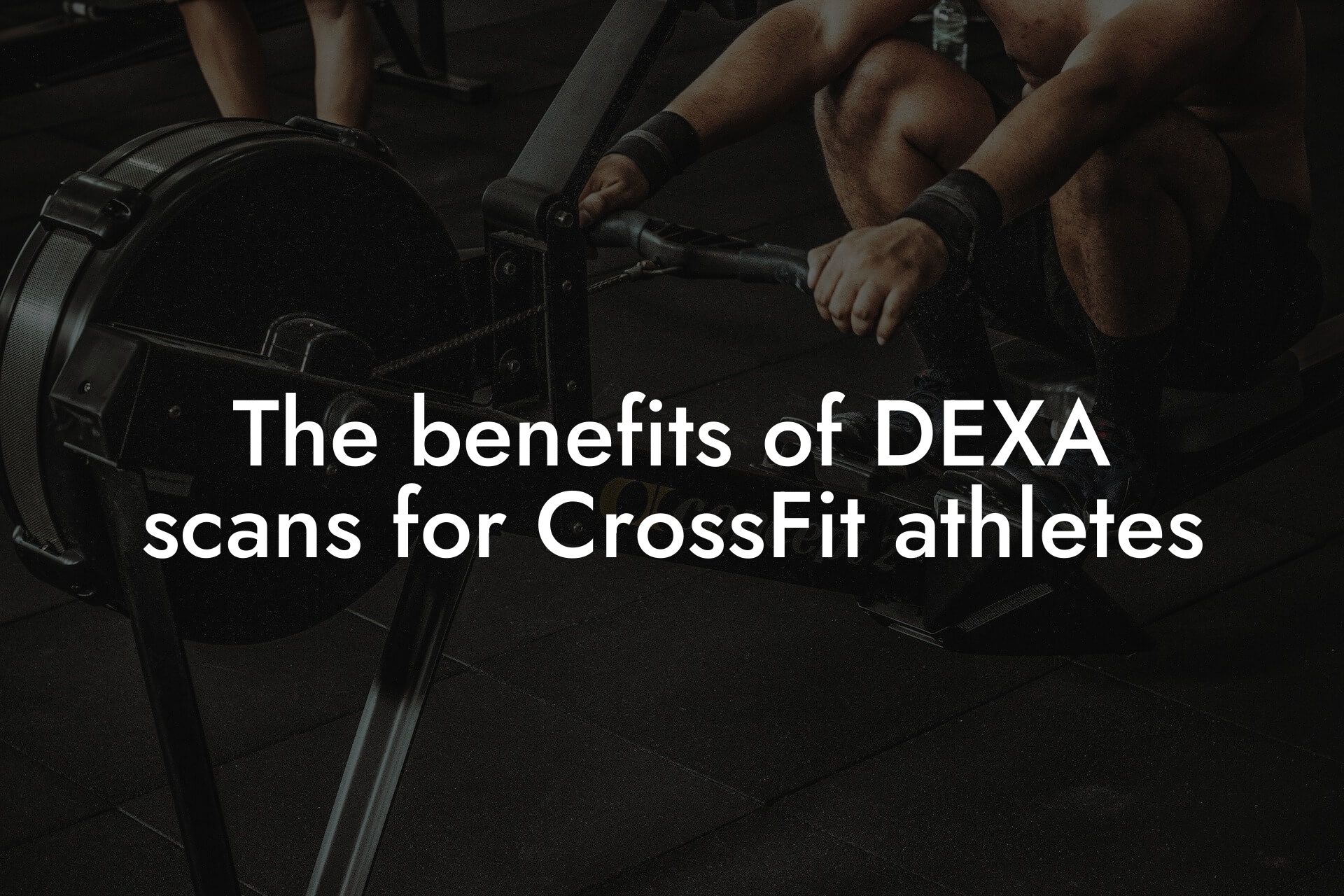As a high-earning professional, you understand the importance of taking care of your physical appearance and overall health. Engaging in intense CrossFit workouts can be rewarding, but it's equally important to prioritize recovery to avoid injury, optimize performance, and maintain a healthy physique. In this article, we'll delve into the essential recovery techniques for CrossFit athletes after intense WODs (Workouts of the Day).
Table of Contents
Understanding the Importance of Recovery
Recovery is a critical component of any exercise program, especially for CrossFit athletes who push their bodies to extreme limits. During intense WODs, your muscles undergo micro-tears, and your body experiences physiological stress. If you don't allow your body sufficient time to recover, you may experience fatigue, decreased performance, and increased risk of injury. Adequate recovery enables your body to repair and adapt, leading to improved performance, increased strength, and enhanced overall health.
Immediate Post-WOD Recovery Techniques
After an intense WOD, it's essential to focus on immediate recovery techniques to help your body transition from an anaerobic state to a parasympathetic state. This includes:
1. Stretching and Foam Rolling: Spend 10-15 minutes stretching your major muscle groups, focusing on areas that were heavily engaged during the WOD. Use a foam roller to release tension and promote blood flow.
2. Hydration and Electrolyte Replenishment: Drink 16-20 ounces of water or a sports drink to replenish lost fluids and electrolytes. Aim to consume a 3:1 or 4:1 ratio of carbohydrates to protein within 30-60 minutes post-WOD.
3. Breathing Exercises and Relaxation Techniques: Engage in deep, diaphragmatic breathing exercises to calm your nervous system and reduce cortisol levels. Try techniques like box breathing, progressive muscle relaxation, or meditation to promote relaxation.
Short-Term Recovery Techniques (0-24 hours)
In the hours following an intense WOD, your body continues to repair and adapt. Implement the following short-term recovery techniques to optimize your recovery:
1. Active Recovery: Engage in low-intensity aerobic activities like cycling, swimming, or light cardio to promote blood flow and aid in the removal of waste products.
2. Compression Garments and Elevation: Wear compression clothing or use compression wraps to improve blood flow and reduce swelling. Elevate your legs above the level of your heart to reduce inflammation and promote lymphatic drainage.
3. Cryotherapy and Heat Therapy: Apply ice or cold water immersion for 10-15 minutes to reduce inflammation and muscle spasms. Alternatively, use heat therapy to promote relaxation and increase blood flow.
Long-Term Recovery Techniques (24-48 hours)
In the 24-48 hour window following an intense WOD, your body continues to adapt and repair. Implement the following long-term recovery techniques to optimize your recovery:
1. Massage and Soft Tissue Work: Treat yourself to a massage or engage in self-myofascial release techniques to promote relaxation, reduce muscle tension, and improve range of motion.
2. Electrostimulation and NormaTec: Use electrostimulation devices or NormaTec compression sleeves to enhance blood flow, reduce inflammation, and promote muscle recovery.
3. Sleep and Nutrition: Prioritize adequate sleep (7-9 hours) to allow your body to recover and adapt. Focus on consuming a balanced diet rich in protein, complex carbohydrates, and healthy fats to support muscle repair and growth.
Supplementation for Recovery
While a balanced diet is essential, supplements can help support your recovery. Consider the following:
1. Protein Powder: Consume a post-WOD protein shake containing 20-30 grams of protein to support muscle repair and growth.
2. BCAAs and Glutamine: Take 5-10 grams of branched-chain amino acids (BCAAs) and 5-10 grams of glutamine to reduce muscle soreness, promote recovery, and support immune function.
3. Omega-3 Fatty Acids and Antioxidants: Consume 1-2 grams of omega-3 fatty acids and antioxidants to reduce inflammation, promote recovery, and support overall health.
Monitoring Your Recovery
It's essential to monitor your recovery to ensure you're adapting to the demands of CrossFit. Keep track of:
1. Heart Rate Variability (HRV): Use a heart rate monitor to track your HRV, which can indicate your body's readiness for intense exercise.
2. Subjective Feedback: Pay attention to your perceived exertion, muscle soreness, and overall fatigue to adjust your training and recovery strategies.
3. Body Composition Analysis: Regularly track your body composition using a DEXA machine, like those offered by Tano Performance Group, to monitor changes in body fat, lean mass, and bone density.
Creating a Personalized Recovery Plan
Every individual is unique, and what works for one person may not work for another. Experiment with different recovery techniques to find what works best for you. Consider the following:
1. Listen to Your Body: Pay attention to your body's signals, and adjust your recovery plan accordingly.
2. Periodize Your Recovery: Alternate between intense training phases and lighter recovery phases to avoid burnout and promote long-term progress.
3. Seek Professional Guidance: Consult with a qualified coach, trainer, or healthcare professional to create a personalized recovery plan tailored to your specific needs and goals.
Frequently Asked Questions
What is the importance of recovery techniques for CrossFit athletes?
Recovery techniques are crucial for CrossFit athletes as they help to repair and rebuild muscles, tendons, and ligaments that are damaged or stressed during intense WODs (Workouts of the Day). Proper recovery enables athletes to perform at their best, reduces the risk of injury, and enhances overall physical and mental well-being.
What are some common signs of poor recovery in CrossFit athletes?
Common signs of poor recovery in CrossFit athletes include fatigue, muscle soreness, decreased performance, and increased risk of injury. Athletes may also experience mood swings, insomnia, and decreased motivation.
How does proper recovery improve athletic performance?
Proper recovery improves athletic performance by allowing athletes to train at a higher intensity, increasing muscle strength and endurance, and enhancing speed and agility. It also reduces muscle soreness and fatigue, enabling athletes to perform at their best during competitions.
What are some effective recovery techniques for CrossFit athletes?
Effective recovery techniques for CrossFit athletes include foam rolling, stretching, self-myofascial release, compression garments, cryotherapy, and active recovery techniques such as light cardio and yoga.
How often should CrossFit athletes incorporate recovery techniques into their training?
CrossFit athletes should incorporate recovery techniques into their training at least 2-3 times per week, or as needed based on the intensity and frequency of their workouts.
What is foam rolling and how does it benefit CrossFit athletes?
Foam rolling is a self-myofascial release technique that involves using a foam roller to apply pressure to specific areas of the body. It helps to reduce muscle soreness, improve circulation, and increase range of motion, making it an essential tool for CrossFit athletes.
How does stretching benefit CrossFit athletes?
Stretching benefits CrossFit athletes by improving flexibility, reducing muscle tension, and enhancing range of motion. It also helps to reduce the risk of injury and improve overall athletic performance.
What is self-myofascial release and how does it benefit CrossFit athletes?
Self-myofascial release is a technique that involves applying pressure to specific areas of the body to release tension in the muscles and connective tissue. It helps to reduce muscle soreness, improve circulation, and increase range of motion, making it an essential tool for CrossFit athletes.
How do compression garments benefit CrossFit athletes?
Compression garments benefit CrossFit athletes by improving circulation, reducing muscle soreness, and enhancing recovery. They also provide support and stability to the muscles and joints, reducing the risk of injury.
What is cryotherapy and how does it benefit CrossFit athletes?
Cryotherapy, also known as ice baths, involves immersing the body in cold water to reduce inflammation and muscle soreness. It helps to speed up recovery, reduce muscle damage, and enhance athletic performance.
What are active recovery techniques and how do they benefit CrossFit athletes?
Active recovery techniques, such as light cardio and yoga, involve performing low-intensity exercises to promote blood flow and reduce muscle soreness. They help to speed up recovery, improve circulation, and enhance overall athletic performance.
How does nutrition play a role in recovery for CrossFit athletes?
Nutrition plays a critical role in recovery for CrossFit athletes. A balanced diet that includes protein, complex carbohydrates, and healthy fats helps to repair and rebuild muscles, tendons, and ligaments, and supports overall recovery.
What are some essential nutrients for CrossFit athletes to aid in recovery?
Essential nutrients for CrossFit athletes to aid in recovery include protein, creatine, branched-chain amino acids (BCAAs), and omega-3 fatty acids. These nutrients help to repair and rebuild muscles, reduce muscle soreness, and enhance overall recovery.
How much rest and sleep do CrossFit athletes need for optimal recovery?
CrossFit athletes need 7-9 hours of sleep per night and at least one rest day per week for optimal recovery. Adequate rest and sleep help to repair and rebuild muscles, tendons, and ligaments, and support overall recovery.
What are some common mistakes CrossFit athletes make when it comes to recovery?
Common mistakes CrossFit athletes make when it comes to recovery include not incorporating recovery techniques into their training, not getting enough rest and sleep, and not fueling their bodies with a balanced diet.
How can CrossFit athletes incorporate recovery techniques into their busy schedules?
CrossFit athletes can incorporate recovery techniques into their busy schedules by prioritizing recovery, scheduling recovery sessions into their training plans, and finding recovery techniques that can be done on-the-go, such as foam rolling and stretching.
What are some recovery techniques that can be done on-the-go?
Recovery techniques that can be done on-the-go include foam rolling, stretching, and self-myofascial release. These techniques can be done anywhere, anytime, making them ideal for busy CrossFit athletes.
How does recovery impact mental performance in CrossFit athletes?
Recovery has a significant impact on mental performance in CrossFit athletes. Proper recovery helps to reduce stress and anxiety, improve mood, and enhance focus and concentration, leading to better mental performance during competitions.
What are some recovery techniques that can help reduce stress and anxiety in CrossFit athletes?
Recovery techniques that can help reduce stress and anxiety in CrossFit athletes include yoga, meditation, and deep breathing exercises. These techniques help to calm the mind and body, reducing stress and anxiety and promoting overall well-being.
How does recovery impact bone density in CrossFit athletes?
Recovery has a significant impact on bone density in CrossFit athletes. Proper recovery helps to promote bone growth and density, reducing the risk of osteoporosis and fractures.
What are some recovery techniques that can help improve bone density in CrossFit athletes?
Recovery techniques that can help improve bone density in CrossFit athletes include weight-bearing exercises, such as squats and deadlifts, and resistance training exercises, such as push-ups and pull-ups.
How does Tano Performance Group support CrossFit athletes in their recovery?
Tano Performance Group supports CrossFit athletes in their recovery by providing them with the knowledge, tools, and resources they need to optimize their recovery. Our team of experts provides personalized coaching, training plans, and nutrition guidance to help athletes achieve their goals and perform at their best.
Here are some related articles you might love...
- How body composition affects performance in CrossFit
- Balancing strength, speed, and flexibility in CrossFit
- The benefits of DEXA scans for CrossFit athletes
- Nutrition tips for sustaining energy during CrossFit workouts
- The role of muscle mass in CrossFit endurance and power
- Reducing body fat for better performance in CrossFit competitions
- Off-season training strategies for CrossFit athletes
- Bone density and injury prevention in CrossFit
- Strength and conditioning programs for CrossFit athletes
Zak Faulkner
Zak Faulkner is a leading authority in the realm of physical health and body composition analysis, with over 15 years of experience helping professionals optimise their fitness and well-being. As one the experts behind Tano Performance Group, Zak has dedicated his career to providing in-depth, science-backed insights that empower clients to elevate their physical performance and overall health.
With extensive knowledge of DEXA technology, Zak specializes in delivering comprehensive body assessments that offer precise data on body fat, muscle mass, bone density, and overall physique. His expertise enables individuals to make informed decisions and achieve their fitness goals with accuracy and confidence. Zak’s approach is rooted in a deep understanding of human physiology, combined with a passion for helping clients unlock their full potential through personalised strategies.
Over the years, Zak has earned a reputation for his commitment to excellence, precision, and client-focused service. His guidance is trusted by top professionals who demand the best when it comes to their health. Whether advising on fitness programs, nutritional strategies, or long-term wellness plans, Zak Faulkner’s insights are a valuable resource for anyone serious about taking their health and fitness to the next level.
At Tano Performance Group, Zak continues to lead our Content Team revolutionising how professionals approach their physical health, offering unparalleled expertise that drives real results.




